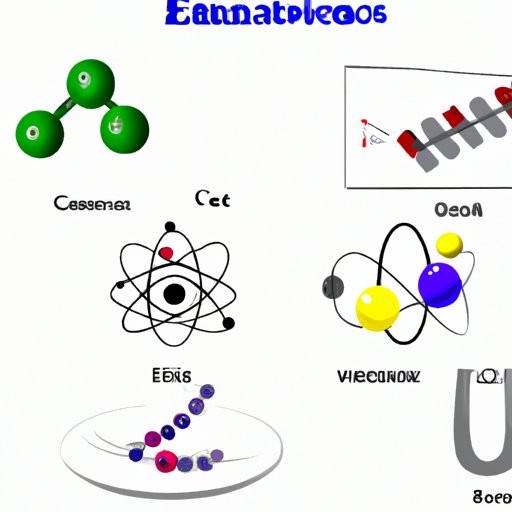An Overview of Elements in Science
Elements are the building blocks of all matter in the universe. They are the fundamental substances that make up all physical objects, from the stars in the sky to the air we breathe. Understanding the basics of elements in science is essential for anyone interested in the physical world.

A Definition of an Element
In simplest terms, an element is a substance composed of only one type of atom. According to the International Union of Pure and Applied Chemistry (IUPAC), “an element is a species of atoms which have the same number of protons in their atomic nuclei.” This means that elements are the most basic forms of matter, as they cannot be broken down into simpler components.
Types of Elements
There are currently 118 known elements in the periodic table. These elements can be divided into three main categories: metals, nonmetals, and metalloids. Metals are elements that are typically shiny, malleable, and good conductors of electricity and heat. Nonmetals are elements that are generally dull, brittle, and bad conductors of electricity and heat. Metalloids are elements that share characteristics of both metals and nonmetals.
Properties of Elements
Each element has its own unique properties that distinguish it from other elements. These properties include things like atomic mass, melting point, boiling point, electrical conductivity, and density. By studying these properties, scientists can learn more about the behavior and structure of elements.

A Guide to the Basics of Elements in Science
To better understand elements in science, it is important to learn more about their atomic structure, chemical bonding, and the periodic table. Each of these topics provides valuable insight into the fundamentals of elements.
Atomic Structure
Atoms are the smallest particles of an element and are made up of three subatomic particles: protons, neutrons, and electrons. The number of protons in an atom determines its atomic number and thus what element it is. For example, all hydrogen atoms have one proton, and all oxygen atoms have eight protons.
Chemical Bonding
Atoms are held together by chemical bonds, which form when two or more atoms share electrons. Different types of bonds form depending on the number of electrons shared and the strength of the bond. Stronger bonds, such as covalent bonds, require more energy to break than weaker bonds, such as ionic bonds.
Periodic Table
The periodic table is a chart that organizes the elements according to their atomic number, electron configuration, and chemical properties. It is an invaluable tool for understanding the different properties of elements and how they interact with each other.

The Chemistry Behind Elements in Science
Elements are essential to the study of chemistry, as they are the building blocks of all compounds and mixtures. Through the study of chemical reactions, scientists can learn more about the behavior of elements and how they interact with each other.
Chemical Reactions
Chemical reactions involve the rearrangement of atoms to form new compounds. During a reaction, atoms gain or lose electrons and form new bonds with other atoms. By studying chemical reactions, scientists can gain a better understanding of how elements interact with each other.
Compounds and Mixtures
Compounds are molecules composed of two or more elements bonded together. Mixtures, on the other hand, are combinations of elements that are not chemically bonded. Both compounds and mixtures are essential to the study of chemistry.
Valence Electrons
The outermost shell of an atom is called the valence shell. Valence electrons are the electrons in this shell, and they play an important role in determining how atoms interact with each other. By studying valence electrons, scientists can gain a better understanding of how elements form compounds and mixtures.
How Elements Are Used in Scientific Experiments
Elements are essential to a variety of scientific experiments, including physical, chemical, and biological experiments. In physical experiments, elements may be used to study the properties of matter, such as density, melting point, and boiling point. In chemical experiments, elements are used to study the behavior of compounds and mixtures. In biological experiments, elements are essential to studying the structure and function of living organisms.
What Makes an Element Unique in Science
Each element is unique in its own way, and there are three main factors that determine what makes an element unique: its atomic number, electron configuration, and isotopes. The atomic number of an element is the number of protons in its nucleus, and this determines what element it is. The electron configuration of an element is its arrangement of electrons in shells around its nucleus, and this determines how it interacts with other elements. Isotopes are variants of an element with different numbers of neutrons in their nuclei, and these can affect the properties of an element.
Elements are the fundamental building blocks of all matter in the universe, and understanding their properties and behavior is essential for scientists of all disciplines. By studying the basics of elements in science, from their atomic structure to their chemical bonding and beyond, scientists can gain a better understanding of how elements interact with each other and how they are used in scientific experiments.
Conclusion
Elements are the foundation of all matter in the universe, and learning about them is essential for anyone interested in the physical world. This article has provided an overview of elements in science, including their definitions, types, properties, atomic structures, chemical bonding, and more. Additionally, it has discussed how elements are used in scientific experiments and what makes them unique. With this knowledge, scientists can further explore the fascinating world of elements and their impact on our lives.
(Note: Is this article not meeting your expectations? Do you have knowledge or insights to share? Unlock new opportunities and expand your reach by joining our authors team. Click Registration to join us and share your expertise with our readers.)
